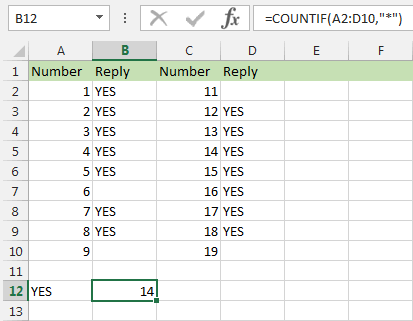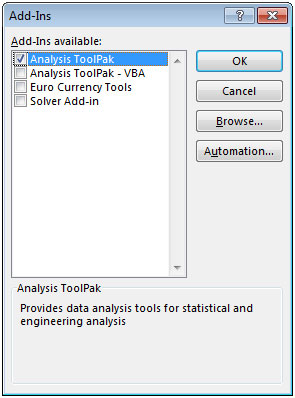
- Install data analysis in excel for mac late 2010 code#
- Install data analysis in excel for mac late 2010 download#
- Install data analysis in excel for mac late 2010 mac#
Do you want other baseline years for the Main Module? Refer to the AVERT User Manual and Quick Start Guide for step-by-step instructions on using the Main Module. You can choose your region of analysis on the main screen and upload the relevant regional data file to the tool.
Install data analysis in excel for mac late 2010 mac#
Mac OS: Select “Enable macros” in the dialog box that appears when opening the file. Windows: Navigate to the “Trust Center” in the “Options” menu, then select Trust Center Settings > Macro Settings > Enable all macros. To use AVERT’s Main Module, open the AVERT Main Module.xlsx file. EPA recommends that analysts using AVERT to assess annual, near-term future avoided emissions continue to use the 2019 data year RDFs with AVERT Main Module v3.1. Users should note that due to temporary declines in electricity demand in 2020, particularly in the months of March through May, the 2020 RDFs may not be appropriate for certain analyses. Regional Data Files for 20, the most recent years available ( find your region): Install data analysis in excel for mac late 2010 download#
Download the following files to the same folder on a local computer or drive: The Main Module can also be used in Excel 2011 or newer for Mac.
The AVERT Web Edition still uses 2019 RDFs but reflects the updated Main Module with respect to onshore wind capacity factors.ĪVERT’s Main Module requires Excel 2007 or newer to run in Windows. Incorporated PM 2.5, VOCs, and NH 3 data from the National Emissions Inventory (NEI). Updated onshore wind power profiles and capacity factors in the Main Module. Removed “worst-case” substitute emissions data points from the underlying CAMD input files. Added statewide analysis functionality (web AVERT only).  Added the ability to scale RE capacity factors (Excel-based AVERT only). The 14 new AVERT regions are based on aggregations of one or more balancing authority(ies). Revised AVERT regions to reflect the modern electric grid. Energy Information Administration (EIA), which provides unique values for each year. Incorporated line loss factors from the U.S. Users can now output AVERT calculations to COBRA and SMOKE formats even if the modeled EE/RE changes in load exceed AVERT’s recommended limit of 15% of regional load in any hour. Added new pop-up box to “Step 3: Run Scenario” that explains how a user can remedy entered generation change that exceeds both the recommended and calculable ranges of AVERT. Added new columns on “Manual Energy Profile Entry” page that tell the user when the entered generation change exceeds both the recommended and calculable ranges of AVERT in each hour.
Added the ability to scale RE capacity factors (Excel-based AVERT only). The 14 new AVERT regions are based on aggregations of one or more balancing authority(ies). Revised AVERT regions to reflect the modern electric grid. Energy Information Administration (EIA), which provides unique values for each year. Incorporated line loss factors from the U.S. Users can now output AVERT calculations to COBRA and SMOKE formats even if the modeled EE/RE changes in load exceed AVERT’s recommended limit of 15% of regional load in any hour. Added new pop-up box to “Step 3: Run Scenario” that explains how a user can remedy entered generation change that exceeds both the recommended and calculable ranges of AVERT. Added new columns on “Manual Energy Profile Entry” page that tell the user when the entered generation change exceeds both the recommended and calculable ranges of AVERT in each hour. 
Install data analysis in excel for mac late 2010 code#
Corrected code in the Statistical Module to ensure that AVERT will work with the newest version of MATLAB.Added output files compatible with EPA’s CO-Benefits Risk Assessment (COBRA) Health Impact Screening Tool.Removed mismatches in AMPD-to-AVERT data import pipeline.Corrected summation of annual NO X values.Improved the way data are extrapolated for peak hours.Adjusted the Statistical Module and Regional Data Files to account for additional generation impacts associated with parasitic loads at the point of generation.Corrected peak-day-finding formula in post-processing sheets.Corrected unit labeling of NO x and SO 2 data blocks in RDFs.Updated compatibility to Excel for Mac 2016.Added caution message for larger-than-recommended energy profiles.

Modified rounding of outputs to tens rather than hundreds place.Added daily avoided NO x by county output.
 Added adjustment factor to account for avoided line losses associated with EE and distributed RE profiles. Added compatibility with Excel for Mac 2011. Instructions added for states that reside in multiple AVERT regions. New pop-up box depicts percent generation in each state within an AVERT region. Corrected transposition of NO x and SO 2 columns in the Monthly Impact Data by County table in Step 4. Modified default wind capacity factor data to more closely represent measured wind speeds. AVERT Main Module Version History Version #
Added adjustment factor to account for avoided line losses associated with EE and distributed RE profiles. Added compatibility with Excel for Mac 2011. Instructions added for states that reside in multiple AVERT regions. New pop-up box depicts percent generation in each state within an AVERT region. Corrected transposition of NO x and SO 2 columns in the Monthly Impact Data by County table in Step 4. Modified default wind capacity factor data to more closely represent measured wind speeds. AVERT Main Module Version History Version #








 0 kommentar(er)
0 kommentar(er)
